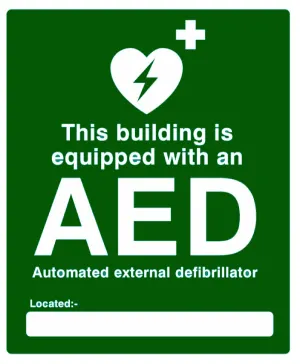
Where to place your AED?
Where should your AEDs inside an office or building in order to have an optimal response time?
There are a few things to consider when identifying how many AED devices are best for you and where you might install them. The major goal for any PAD (Public Access Defibrillation) is to attain a 3-minute reaction time from a patient’s collapse time to the arrival of the AED. When making any choices about placement, use this 3-minute response time on where to place and how many devices to use.
 Reaction Time
Reaction Time
The less time that passes between the patient collapse time and the shock is delivered, the more likely the patient will survive. The purpose is to get the AED to the patient in not more than 3 minutes. This would mean that the AED must be within 90 seconds of the patient, in case you want to go from the patient’s vicinity to the AED and back. Since you don’t know precisely where the patient will be, place the AED at a strategic location, so it’s accessible to everyone.
Rate of Incidence
Another essential thing when identifying where to place the AED is to know where cardiac emergencies are higher than normal. Also, choose areas where cardiac incidents will most likely occur, and there are two most important concerns to keep in mind.
The number of Employees and Visitors
One factor to consider is that we need to install the AED (Automated External Defibrillator) in high walking traffic like in places in the office or areas with high population density. For example, the pantry, lobby, entrance, and exits of the building.
High-Risk Activity
Another important factor that requires the location of an AED in nearby places includes those with high-risk activities. One example is an area where there is a physical activity that will raise the heart rate, such as fitness centers, swimming pools, or other recreational places. Also, areas with a higher level of physical activities, such as the warehouse or assembly lines are at a higher chance of cardiac emergencies.
Right Location Matters
Determine the areas with the fastest routes using these basic tools: a floor plan, a stopwatch, and a clipboard. First, the floor plan, look for highly accessible areas where the AED can be installed, or in high walking traffic, and visible to most people. When determining the time it takes to get the AED to a suspected patient, consider delays like elevators, stairs, and off-limits or restricted areas. Then, take your watch to the proposed AED location and start timing.
Bear in mind that you need to time this test while walking at a quick pace and not by running. Walk north for 90 seconds and mark the place you’re standing on the floor plan. Go back to your proposed AED area and repeat the test for the south, east, and west. You must end up with four marked areas around your proposed AED installation area.
Lastly, encircle areas that indicate a radius of 90 seconds from your proposed AED installation area. You can see that these areas are covered and what areas are not included. When densely populated areas have circles that are overlapping, you did the right job in protecting as many stakeholders as possible.
Remember, once the AED reaches the patient, it should take less than 90 seconds to deliver a shock. The ‘drop-to-shock’ time is vital to successful defibrillation.
Physical Placement
Once you know how many AEDs are needed, it is critical to consider the actual installation site. It must be accessible to trained rescuers if possible. The AED itself must be safe and secure. Also, the location must have a nearby telephone with access so that 911 can be dialed easily. Lastly, it must be in a location that either all employees know about or can be advised of. Examples are the main lobby, pantry, hallway, first aid station, gym, or security post.
Potential Problems
Vertical Response Time
Take note that reaction or response time is determined based on how long it takes to reach a suspected patient. This means that office cubicles, high-rise buildings, and multi-floor areas provide obstacles that will affect the reaction time. But in the case of a small building, it is usually recommended that a minimum of one AED unit be installed on each floor. It is also advised that you calculate the reaction time by using a route that includes stairs as opposed to an escalator or elevator.
Hard to Access Areas
Any place that is difficult to access must have its own AED. For security or workflow purposes many companies will often have work areas that are sectioned off from the rest of the building. One example includes locked or restricted areas that require keys, an access card, biometrics, or any codes to enter. And an area that is highly sensitive and off-limits to the majority of staff should have its defibrillation unit, whether it’s a research facility, executive level, or a warehouse with inventory that is being safeguarded.
Other Considerations
Not all corporate activities happen at the actual location. Consider all possibilities that might require employee attendance, conferences, and other off-site meetings. For example, a scenario where attendance is optional but likely is also very important, such as special events like holiday parties, and company activities.
Patient survival rates decrease by 7% to 10% every minute that an AED is delayed. But by having AED units nearby at your place you will drastically improve the survival percentage of your employees whenever there is a cardiac emergency.

